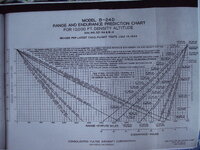ThomasP
Chief Master Sergeant
Hey Geoffrey Sinclair,
re the ranges of the B-17 and B-24 in the report up-thread.
The model of the B-17 used was a B-17E with modifications to emulate the upcoming B-17F production with Tokyo tanks. The B-24 model was the B-24D with Tokyo tanks added. Basically, they were doing proof of concept tests for the upcoming long range bomber operations in Europe.
re the "6,300 miles at 156 mph" for the B-24D.
Where did you find that? It should be 3600 miles (I think).
re the ranges of the B-17 and B-24 in the report up-thread.
The model of the B-17 used was a B-17E with modifications to emulate the upcoming B-17F production with Tokyo tanks. The B-24 model was the B-24D with Tokyo tanks added. Basically, they were doing proof of concept tests for the upcoming long range bomber operations in Europe.
re the "6,300 miles at 156 mph" for the B-24D.
Where did you find that? It should be 3600 miles (I think).
Last edited:

